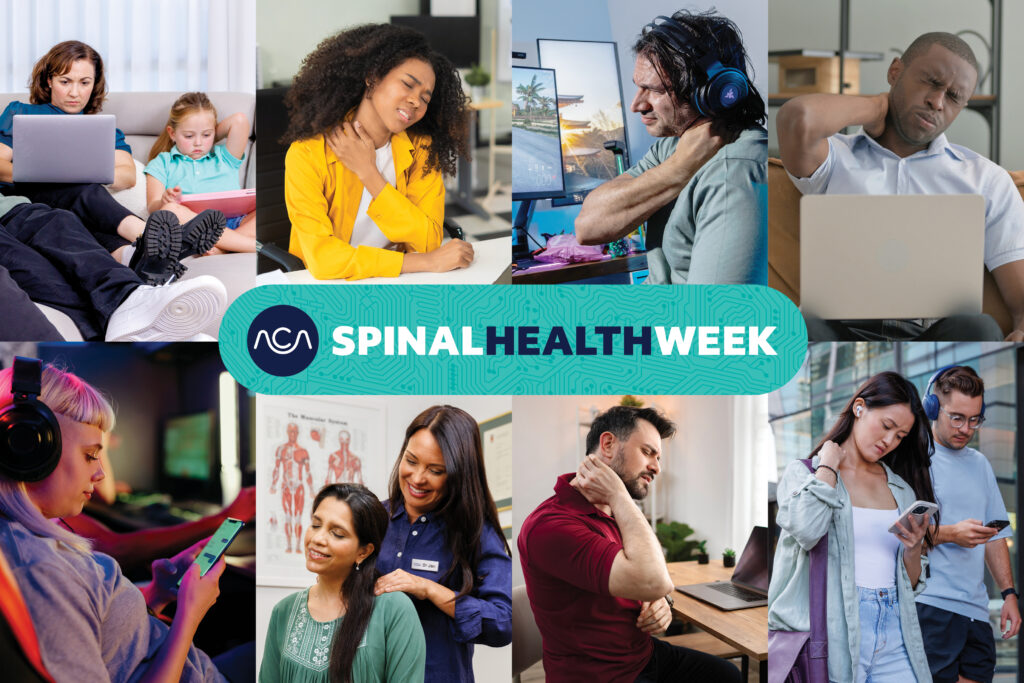National Spinal Health Week (26 May to 1 June 2025) is an initiative of the Australian Chiropractors Association (ACA). This annual community health initiative aims to shine a spotlight on spinal health issues affecting millions of Australians and how we as individuals and communities can take proactive steps to improve spinal health across our nation.
In 2025, our campaign targets Tension Neck Syndrome. Commonly known as ‘tech neck’ or ‘text neck’, the condition is a global health concern caused by poor posture and the prolonged or incorrect use of digital devices, including smartphones, tablets and computers.
With musculoskeletal disorders (MSDs) including tech neck costing the Australian economy over $55 billion annually, and neck pain now affecting 1 in 5 Australians, Spinal Health Week aims to educate Australians about the risks of developing tech neck and provide tips on how to prevent the disorder.
Who are most at risk of tech neck?
Anyone who regularly uses a mobile phone, tablet or computer at home, work or school or during leisure time, is at risk of developing tech neck.
With over 34 million mobile phone connections and 95 percent of the Australian population accessing the internet via a smartphone, spending too much time with the head bent forward reading or scrolling smartphones or tablets has been proven to cause tech neck.
Prolonged or incorrect computer use is also linked to tech neck, putting the 75.5% of Australians aged 16–64 who use computers daily – particularly office workers and students – at greater risk.
What causes tech neck?
Incorrect and non-ergonomic posture habits while using mobile devices including smartphones and tablets, and poorly set up computers (including laptops) at home, school, university or in the workplace, can lead to the development of tech neck.
What are the spinal health implications of unresolved tech neck?
Unresolved tech neck can be debilitating, leading to headaches, neck, shoulder, and upper back pain. The severity of symptoms often correlates with the amount of time spent using smartphones or other electronic devices like tablets and computers. Over time, this can even alter the natural curve of the cervical spine.
How to prevent tech neck?
To help prevent tech neck, avoid incorrect, non-ergonomic posture habits when using smart devices and computers. Maintain good posture, take frequent breaks at regular intervals and do stretching exercises.
How to prevent tech neck?
To help prevent tech neck, avoid incorrect, non-ergonomic posture habits when using smart devices and computers. Maintain good posture, take frequent breaks at regular intervals and do stretching exercises.
- SIT WITH COMFORTABLE UPRIGHT POSTURE with shoulders relaxed and feet flat on the floor.
- STOP BENDING YOUR NECK to look down at a phone or tablet. Hold the device at eye level.
- LIMIT THE TIME spent using a phone to 2 hours per day, especially during leisure time.
- USE BOTH HANDS or alternate between left and right when typing on a smartphone.
- DON’T WALK LOOKING DOWN at a phone. Hold your head up straight and engage with the world.
- TAKE REGULAR MOVEMENT BREAKS to look away from your device, move your neck from side to side and stretch every 10 minutes if using mobile devices and every 30 minutes if using computers.
- ENSURE COMPUTERS are ergonomically set up correctly so the monitor is at eye level.
- USE AN ADJUSTABLE ergonomic office chair so the knees are slightly lower than the hips.
- EXERCISE REGULARLY to maintain a healthy spine and overall health and wellbeing.
- CONSULT AN ACA CHIROPRACTOR to limit and treat spinal health problems, including tech neck.
What you can do during National Spinal Health Week 2025
Currently, over 6.1 million Australians are living with MSDs which includes debilitating neck pain.
With prevention the best protection, get the heads up on tech neck and join the Spinal Health Week movement to learn and share practical strategies that can help prevent tech neck, support spinal health, and reduce the economic and personal burden of MSDs.
You can register to participate and download ACA’s FREE Avoiding Tech Neck Factsheets for Adults, Parents, and Students, the Ergonomic Checklist, the Mobile Device Use Checklist and the Stand Corrected Stretching Poster available to download from www.spinalhealthweek.org.au.
Minimising the impact of tech neck to improve overall spinal health and wellbeing
For those suffering from tech neck, studies show that it’s crucial to commence treatment promptly to prevent further functional decline. For effective treatment outcomes achieved through a combination of strengthening and stretching exercises, manual therapy and postural correction, consult an ACA chiro.
Every week over 400,000 chiropractic healthcare consultations help create well-adjusted Australians as ACA chiropractors play an important role in improving the spinal health of everyday Australians.
To treat tech neck and improve your overall health and wellbeing, find your local ACA chiropractor by visiting www.findachiro.org.au.



